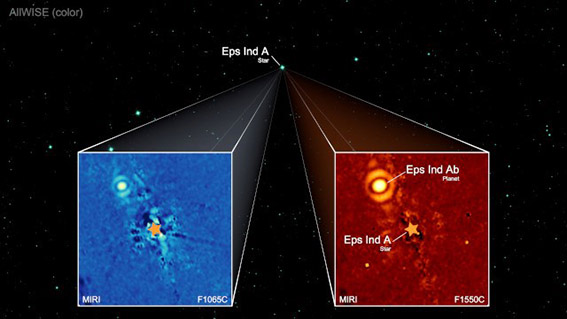Named Epsilon Indi Ab, the exoplanet orbits Eps Ind A, a star slightly smaller and cooler than our Sun, but belonging to the same age class.

Only a few cold gas giant planets orbiting stars the age of the Sun are known to date. They have all been detected indirectly by radial velocity measurements. As planets cool and contract during their evolution, they become much less luminous and therefore more difficult to image.
It was precisely using the radial velocity method that it was possible to identify the presence of Eps Ind Ab, a gas giant, quite similar to Jupiter, although slightly more massive. However, in these earlier studies, which were based on insufficient temporal coverage of the orbit, the mass of the exoplanet, as well as the orbital distance separating it from its host star, had been underestimated.
In fact, Eps Ind Ab needs around 200 years to make a complete orbit around its star. Observations over a few years were therefore insufficient to determine its orbit with any great precision.
In order to characterise this planet’s orbit more precisely, a team of astronomers led by the MPIA and including two researchers from Observatoire de Paris - PSL, envisaged another detection approach : direct imaging. This was made possible by the JWST’s unprecedented imaging capabilities in the thermal infrared.
| [The MIRI coronagraph, an instrument based on the expertise of Paris Observatory - PSL The team chose to use the JWST’s MIRI (Mid-Infrared Instrument) camera, equipped with a coronagraph designed and built at LESIA at Observatoire de Paris - PSL in collaboration with CEA. Its phase mask attenuates the light from the star, creating an artificial eclipse. These observations also benefited from the ’proximity’ (on a cosmic scale) of Eps Ind A to the Earth, which is only 12 light-years away. The closer the star, the greater the angular separation from the planet in the image, which reduces the contamination of the host star’s light on the planet. MIRI proved to be an excellent choice, as the instrument operates in the mid-infrared, revealing cold, faint objects. |
What makes Eps Ind Ab interesting ?
This planet is one of the coldest exoplanets observed to date. With a temperature approaching zero degrees Celsius, it is much colder than the vast majority of other exoplanets imaged to date.

Eps Ind Ab orbits its host star Eps Ind A in an eccentric, elliptical orbit, with its furthest point expected to be between 20 and 40 astronomical units. This orbit is equivalent to that of Neptune around the Sun.
Direct imaging of exoplanets is particularly useful for characterising them. Scientists can directly collect their light at different wavelengths. In this case, for the exoplanet Eps Ind Ab, the analysis was based on three available images : two from JWST/MIRI and one obtained on the ground from the VLT’s VISIR instrument.
Eps Ind Ab is less luminous than expected at short wavelengths. This could indicate the presence of large quantities of heavy elements, in particular carbon, which gives rise to molecules such as methane, carbon dioxide and carbon monoxide, commonly found in gas giant planets. It could also indicate that the planet has a cloudy atmosphere.
Eps Ind Ab thus offers a unique opportunity to study the atmospheric composition of true Solar System analogues.
Reference
This work, led by Elisabeth Matthews, a researcher at the Max Planck Institute for Astronomy in Germany, was published under the title "A temperate super-Jupiter imaged with JWST in the mid-infrared ", in an article in the journal Nature, on 24 July 2024.
DOI : 10.1038/s41586-024-07837-8
